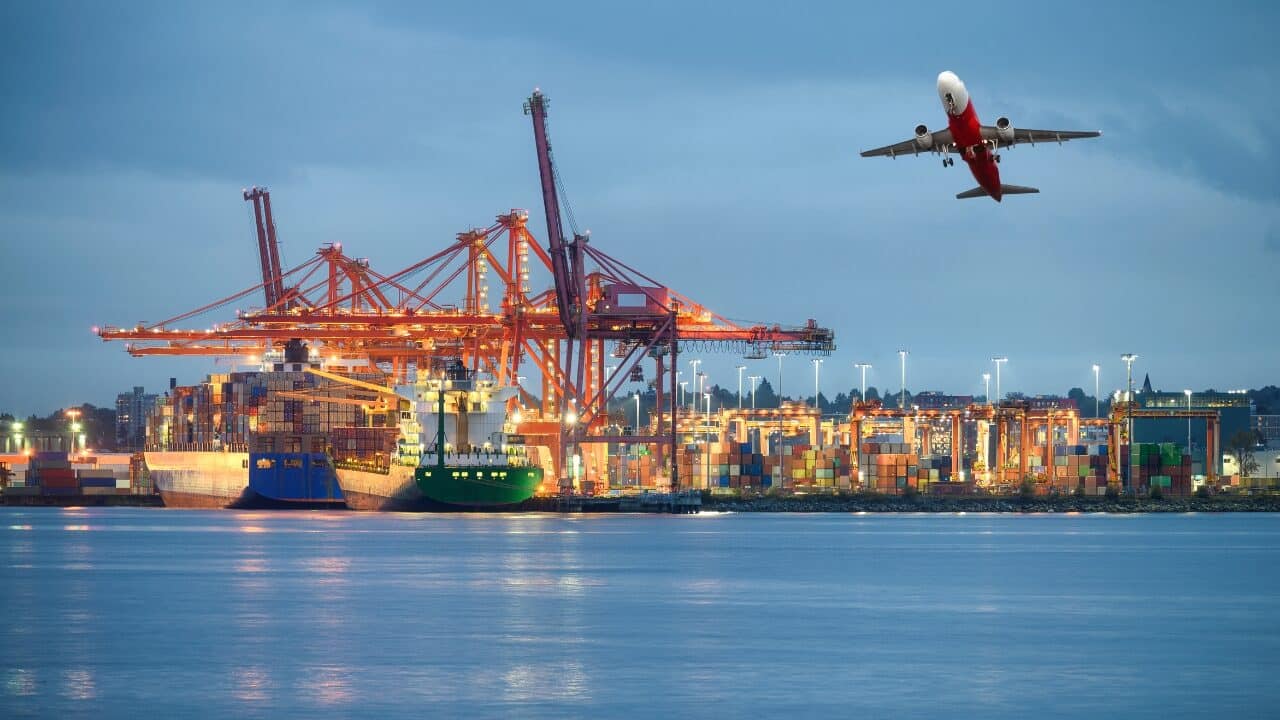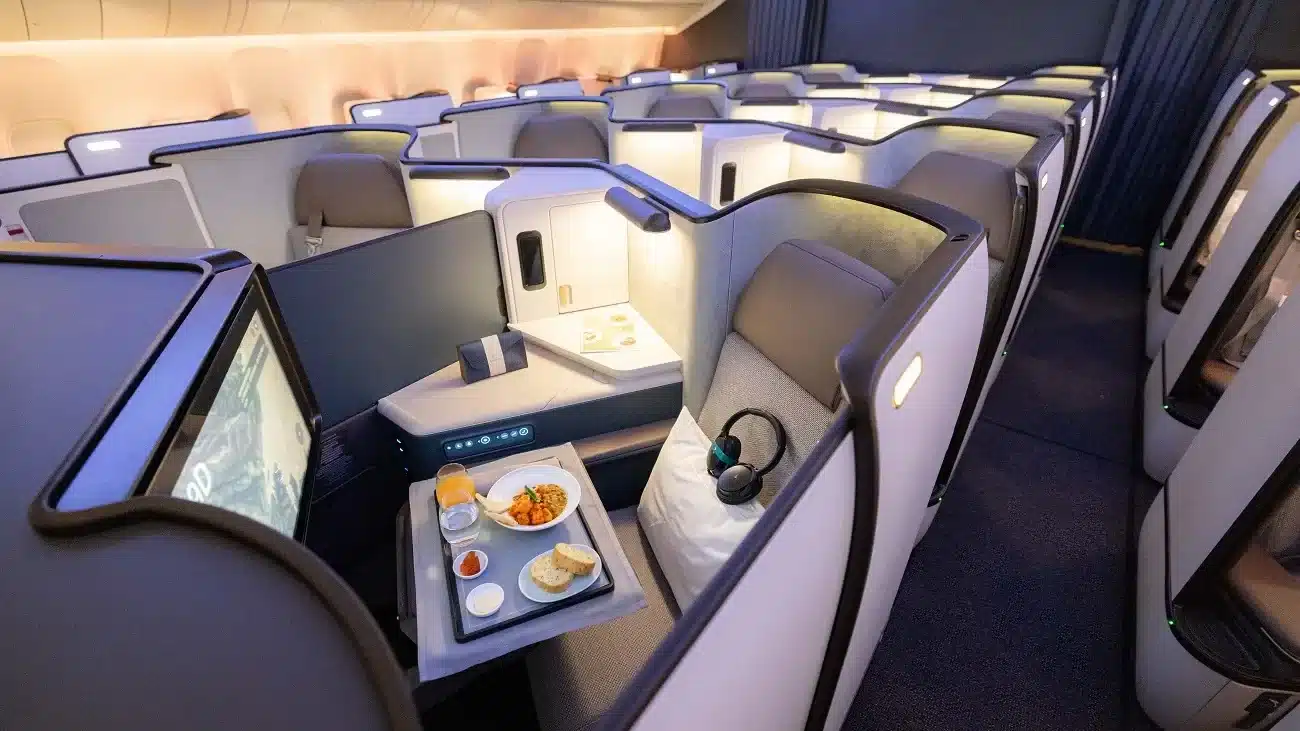Choosing between air freight vs sea freight remains one of the most critical decisions in global supply chain management. With international trade volumes reaching record levels, businesses face increasing pressure to optimize shipping costs while maintaining delivery reliability.
This comprehensive analysis examines the cost structures, time efficiency, and strategic considerations that determine which freight mode delivers the best value for your business.
Understanding the Basics of Air and Sea Freight
Air cargo operates through dedicated freighter aircraft and passenger belly cargo compartments, connecting major trade hubs within hours or days. Modern freighters like the Boeing 747-8F can carry up to 140 tons of cargo across intercontinental distances, while passenger aircraft utilize lower deck space for high-value shipments.
The aircraft cargo sector has evolved to handle increasingly complex logistics requirements with specialized handling facilities.

Ocean shipping relies on containerized vessels that transport goods in standard Twenty-foot Equivalent Units (TEUs). A single Ultra Large Container Vessel (ULCV) can carry over 24,000 TEUs, making sea freight the backbone of global trade. These massive vessels follow established shipping lanes connecting major airports and ports worldwide.

Key Differences Between Air and Ocean Transport
The fundamental distinctions between these freight modes extend beyond speed and cost. Air freight cost analysis reveals that while air transport delivers unmatched velocity, sea freight provides economies of scale that dramatically reduce per-unit costs for large shipments.
Transit time comparison:
- Air freight: 1-7 days door-to-door (Asia-Europe: 2-3 days)
- Sea freight: 15-45 days port-to-port (Asia-Europe: 30-35 days)
Capacity differences:
- Air cargo: Weight-limited (typically up to 100 tons per shipment)
- Ocean freight: Volume-optimized (20-foot or 40-foot containers)
Cost Comparison: Which Freight Method Saves More?
The cost difference between air and sea freight can vary by a factor of 5-10x, depending on cargo specifications, route, and market conditions. Understanding these variables enables logistics managers to make informed decisions that balance budget constraints with operational requirements. Professional aviation logistics consultants can help optimize these critical choices.
Air Freight Pricing Factors (Per Kg, Fuel, Handling)
Air cargo vs sea shipping pricing operates on fundamentally different models. Air freight typically charges by either actual weight or volumetric weight (whichever is greater), calculated as Length × Width × Height ÷ 6000 (cm³/kg).
Primary cost components:
- Per-kilogram rates: $3-8 per kg (varies by route and volume)
- Fuel surcharges: 20-35% of base rate (fluctuates with oil prices)
- Security screening: Mandatory TSA/aviation security fees
- Airport handling: Terminal charges, customs clearance
- Documentation: Airway bills, compliance certificates
Example calculation: A 500 kg electronics shipment from Shanghai to Frankfurt:
- Base rate: $4.50/kg = $2,250
- Fuel surcharge (25%): $562.50
- Handling & documentation: $350
- Total estimated cost: $3,162.50
Peak season surcharges during Q4 can add 15-30% to these baseline costs. Many aviation finance specialists recommend factoring these variations into annual budgets.
Sea Freight Costs (Per TEU, Port Fees, Insurance)
Sea freight cost comparison centers on container rates rather than weight-based pricing. The logistics cost-benefit equation shifts dramatically when shipping full container loads (FCL) versus less-than-container-load (LCL) consolidations.
Standard pricing structure:
- 20-foot container (TEU): $1,200-3,500 (route-dependent)
- 40-foot container (FEU): $1,800-5,000
- Port fees: $200-600 per container (origin + destination)
- Customs clearance: $150-400
- Cargo insurance: 0.2-0.5% of cargo value
- Inland transport: Varies by distance from port
Example calculation: A 40-foot container from Shanghai to Rotterdam:
- Ocean freight: $2,800
- Origin port charges: $280
- Destination port charges: $350
- Insurance (cargo value $50,000): $150
- Total estimated cost: $3,580 for up to 28 tons
Per-kilogram cost for a full 28-ton load: $0.13/kg – approximately 95% cheaper than air freight. Aviation insurance providers often offer combined air and sea coverage packages for businesses using multiple freight modes.
| Cost Factor | Air Freight | Sea Freight |
|---|---|---|
| Per kg rate | $3-8 | $0.10-0.20 (FCL) |
| Fuel impact | High (25-35% surcharge) | Moderate (10-15% surcharge) |
| Minimum charges | $150-300 | $1,200-1,500 (TEU) |
| Insurance rates | 0.3-0.5% | 0.2-0.4% |
Time Efficiency and Delivery Reliability
The air freight vs sea freight time comparison reveals that speed advantages come at a premium. However, delivery predictability matters as much as raw transit time for supply chain planning.
When Speed Matters: Air Freight Advantages
Time-sensitive scenarios where air cargo justifies the premium include:
- Perishable goods: Fresh produce, flowers, pharmaceuticals requiring temperature control
- Emergency shipments: Replacement parts, AOG (Aircraft on Ground) components
- Fashion and seasonal items: Products with short selling windows
- High-value electronics: Smartphones, laptops, semiconductors
- Just-in-time manufacturing: Automotive components, industrial machinery parts
The aviation logistics sector has developed sophisticated cold chain solutions that maintain 2-8°C for pharmaceutical shipments across intercontinental routes. Many charter operators specialize in urgent cargo movements when standard scheduled services cannot meet delivery requirements.
Real-world advantage: A pharmaceutical company shipping COVID vaccine shipments from Belgium to Asia chose air freight despite 8x higher costs. The time savings prevented temperature excursions and maintained product efficacy worth millions in inventory value.
When Scale Matters: Sea Freight Efficiency
Sea freight efficiency excels in scenarios prioritizing cost optimization over speed. The freight mode selection process should favor ocean transport for:
- Bulk commodities: Raw materials, textiles, building materials
- Non-perishable consumer goods: Furniture, appliances, clothing
- Heavy machinery: Construction equipment, industrial systems manufactured by aerospace manufacturers
- Large-volume shipments: Full container loads (20+ tons)
- Stable demand products: Items with predictable consumption patterns
Capacity advantage: A furniture manufacturer ships 50 containers monthly from Vietnam to the United States. Annual ocean freight cost: $2.5 million. Equivalent air freight would cost approximately $45 million – completely unviable for this business model.
| Metric | Air Freight | Sea Freight |
|---|---|---|
| Transit time (Asia-Europe) | 2-5 days | 30-35 days |
| Transit time (US-Asia) | 1-3 days | 18-25 days |
| Schedule reliability | 85-92% on-time | 65-75% on-time |
| Tracking visibility | Real-time | Periodic updates |
| Weather impact | Moderate delays | Potential routing changes |
Risk, Safety, and Environmental Impact
International shipping comparison extends beyond financial metrics to encompass cargo security and environmental responsibility.
Cargo Security and Damage Risks
Air freight advantages:
- Reduced handling touchpoints (fewer cargo transfers)
- Enhanced security screening (aviation regulations)
- Climate-controlled environments (better for sensitive goods)
- Lower theft risk (restricted airport access)
- Damage rate: 0.5-1.5% of shipments
Sea freight considerations:
- Multiple container transfers (port to port, port to truck)
- Container condensation risks (humidity control challenges)
- Port congestion delays (extended dwell times)
- Damage rate: 1.5-3% of shipments
- Piracy concerns on specific routes (though rare)
Marine cargo insurance typically costs 0.2-0.4% of shipment value, while air cargo insurance ranges 0.3-0.5%. The difference reflects varying risk profiles between transport modes. Commercial aviation insurance specialists provide comprehensive coverage options for businesses managing multiple freight channels.
CO₂ Emissions and Sustainability Considerations
The environmental dimension of air vs ocean shipping presents stark contrasts. Air freight generates approximately 50x more CO₂ emissions per ton-kilometer than sea freight, making it the least sustainable option for environmentally conscious businesses.
Emissions comparison (per ton of cargo, 10,000 km):
- Air freight: 6,500-7,200 kg CO₂
- Sea freight: 120-150 kg CO₂
- Difference: ~98% lower emissions for ocean transport
Progressive companies increasingly factor carbon footprint into freight mode selection decisions. The European Union’s Carbon Border Adjustment Mechanism (CBAM) will further incentivize lower-emission transport choices.
Sustainable aviation fuel (SAF) offers potential emissions reductions of 70-80% compared to conventional jet fuel, but currently represents less than 0.1% of aviation fuel consumption due to cost premiums and limited production capacity.
Major shipping lines have committed to achieving net-zero emissions by 2050, investing in alternative fuels like liquefied natural gas (LNG), methanol, and hydrogen propulsion systems.
| Environmental Factor | Air Freight | Sea Freight |
|---|---|---|
| CO₂ per ton (10,000 km) | 6,500-7,200 kg | 120-150 kg |
| Emission intensity | 50x higher | Baseline |
| Sustainable fuel adoption | SAF <0.1% of fuel | LNG, methanol pilots |
| Net-zero targets | 2050 (IATA) | 2050 (IMO) |
When Businesses Should Choose Air Freight
Strategic air cargo selection makes financial sense when the cost-benefit analysis demonstrates clear advantages:
Optimal use cases:
- Products with high value-to-weight ratios (jewelry, semiconductors, pharmaceuticals exceeding $100/kg)
- Inventory carrying costs exceed transportation premium (fast-moving consumer electronics)
- Product lifecycle shorter than sea freight transit time (fashion items, tech products)
- Stockout costs significantly exceed freight premiums (critical manufacturing components)
- Market responsiveness drives competitive advantage (e-commerce fulfillment)
The air cargo industry handles approximately 35% of global trade by value despite representing only 1% by volume, demonstrating that which is better air freight or sea freight depends entirely on shipment characteristics.
Industry examples:
- E-commerce giants use air freight for high-velocity SKUs during promotional events
- Automotive manufacturers air ship critical components to prevent production line shutdowns
- Pharmaceutical companies rely exclusively on temperature-controlled air cargo for biologics
When Sea Freight Is the Smarter Choice
Ocean transport optimization delivers superior economics for the majority of global trade:
Ideal scenarios:
- Bulk shipments exceeding 2 tons (when speed isn’t critical)
- Cost-sensitive products with margins under 30%
- Predictable demand allowing extended lead times
- Heavy or oversized cargo impractical for air transport
- Environmental commitments prioritizing sustainability
The sea freight cost comparison becomes increasingly favorable as shipment weight and volume increase. Companies shipping full container loads enjoy per-kilogram costs 90-95% lower than air alternatives.
Strategic example: A textile manufacturer importing 100 containers annually from Bangladesh to Europe spends $350,000 on ocean freight. Air freight equivalent: $6.5 million. The cost savings fund quality improvements and competitive pricing strategies.
Final Thoughts: Balancing Cost, Time, and Business Needs
The air freight vs sea freight decision requires holistic analysis beyond simple rate comparisons. Sophisticated supply chain strategies often employ hybrid approaches, using air freight for demand surges and new product launches while relying on ocean transport for steady-state replenishment.
Decision framework:
Choose air freight when:
- Transit time savings justify 5-10x cost premium
- Product value exceeds $50 per kilogram
- Inventory holding costs exceed transport differential
- Supply chain agility drives competitive advantage
Choose sea freight when:
- Cost efficiency is primary concern
- Products tolerate 3-6 week transit times
- Full container loads optimize economics
- Environmental sustainability matters
Progressive logistics managers increasingly leverage digital platforms and predictive analytics to optimize freight mode selection dynamically based on real-time variables including fuel prices, demand forecasts, and inventory positions. Aviation finance specialists can help structure flexible payment terms that accommodate both freight modes.
The future points toward greater integration between air and ocean freight networks, with air cargo serving as a strategic complement rather than pure alternative to sea transport. Businesses that master this optimization unlock significant competitive advantages in the global marketplace.
Understanding these dynamics enables informed decisions that balance cost, speed, risk, and sustainability – the four pillars of modern supply chain excellence.
Authors
-
Radu Balas: Author
Pioneering the intersection of technology and aviation, Radu transforms complex industry insights into actionable intelligence. With a decade of aerospace experience, he's not just observing the industry—he's actively shaping its future narrative through The Flying Engineer.
View all posts Founder
-
Cristina Danilet: Reviewer
A meticulous selector of top-tier aviation services, Cristina acts as the critical filter between exceptional companies and industry professionals. Her keen eye ensures that only the most innovative and reliable services find a home on The Flying Engineer platform.
View all posts Marketing Manager
-
Marius Stefan: Editor
The creative force behind The Flying Engineer's digital landscape, meticulously crafting the website's structure, navigation, and user experience. He ensures that every click, scroll, and interaction tells a compelling story about aviation, making complex information intuitive and engaging.
View all posts Digital Design Strategist


















